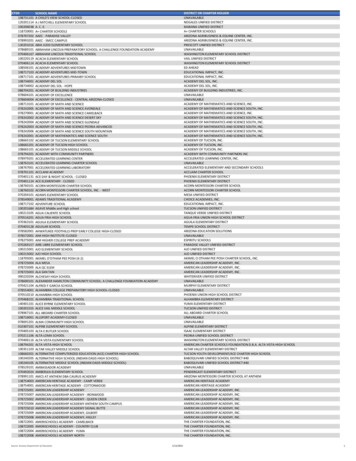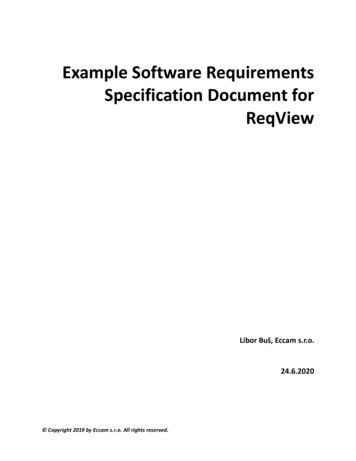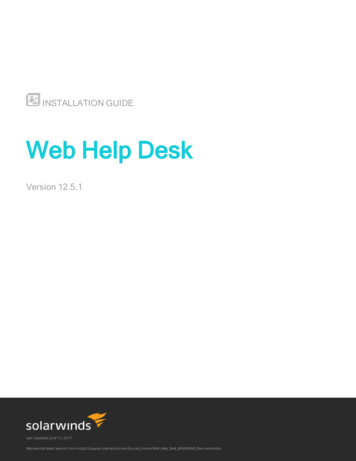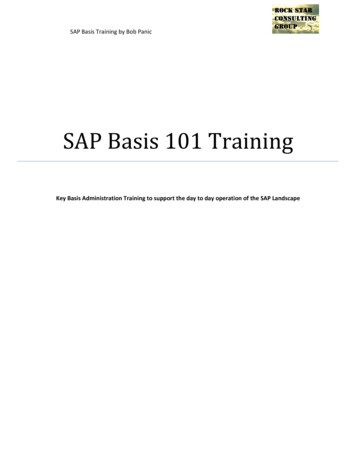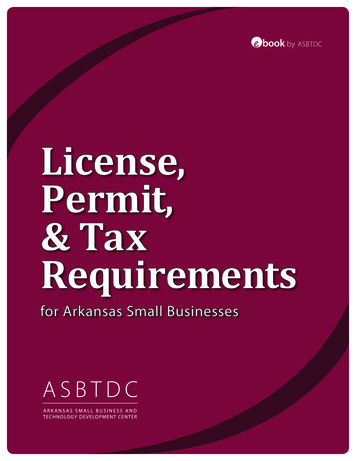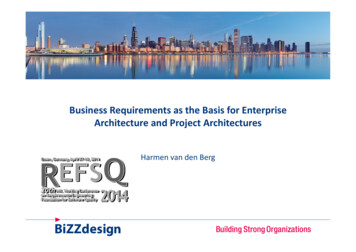
Transcription
Business Requirements as the Basis for EnterpriseArchitecture and Project ArchitecturesHarmen van den Berg
And the speaker is. Harmen van den Berg– Manager BiZZdesign International– Trainer for ArchiMate and TOGAF training courses– Speaker at conferences like LAC, EAC, EAM, Open Group
Let’s get to know each other!Raise your hand: Who is familiar with TOGAF?Who is TOGAF certified?Who is familiar with ArchiMate?Who is using ArchiMate?Who is ArchiMate certified?Who just discovered he or she is in the wrong room? .
Proposed schedule IntroductionThe need for BRMEA and ArchiMateModeling BRMAnalyzing BRMThe process for BRMConclusions
BIZZDESIGN: BUILDING STRONG ORGANIZATIONS!
BiZZdesign: Building Strong Organizations! Organizations increasingly need to deal with businessimprovements and transformations in a complex businessreality. BiZZdesign believes that organizations should havethe change capabilities to improve their business to realizetheir mission. BiZZdesign enables these improvements and improvementcapabilities by providing integrated solutions consisting ofdesign tools, training, business consultancy, and bestpractices. Our integrated solutions are based on community-basedinnovation and open standards, and are executed byexperienced BiZZdesign professionals who are passionateabout improving and empowering organizations.
Service lines BiZZdesignDrive improvements with better decisions aligned on strategy,design, and implementation level: Business Model ManagementEnterprise Architecture ManagementBusiness Process ManagementLean ManagementGovernance, Risk and ComplianceEach service line consists of proven and easy to use softwaretools, best practice models and methods, training, and businessconsultancy
Modules BiZZdesign Tool Suite Modules for modeling, visualizing and analying–––––––Business models based on the Business Model CanvasEnterprise architecture based on ArchiMate and TOGAFRequirements based on ArchiMateProcess models based on BPMN and AmberProcess logic based on The Decision ModelProcess improvement based on LeanData modeling based on UML and ERD With one underlying repository– Including relations between the various models With various publication possibilities– Publication to Html, Word, pdf, publication portal InSite, Wiki
WHY BUSINESS REQUIREMENTS MANAGEMENT?
Requirements.dilbert.com
Why BRM?dilbert.com Actually we know it is important– But do we make a (serious) effort?– And is this effort done right?
“Why” is the reason! In general, only the solution (architecture, process, .) ismodeled, and not the underlying intentions, like goalsand requirements ––––––Why do we need this change, what is the real problem?Who are the stakeholders, what do they want?How do different stakeholder goals influence each other?How are goals translated into requirements?Can we support all business requirements?Why this solution and not another one?
An illustration13
The Standish Group: CHAOS REPORTImpaired projectsProject Impaired Factors1. Incomplete Requirements 13.1%2. Lack of User Involvement 12.4%3. Lack of Resources 10.6%4. Unrealistic Expectations 9.9%5. Lack of Executive Support 9.3%6. Changing Requirements & Specifications 8.7%7. Lack of Planning 8.1%8. Didn't Need It Any Longer 7.5%9. Lack of IT Management 6.2%10. Technology Illiteracy 4.3%Incomplete RequirementsLack of User InvolvementUnrealistic ExpectationsChanging Requirements &Specifications
The Standish Group: CHAOS REPORTProject Challenged Factors1. Lack of User Input 12.8%2. Incomplete Requirements & Specifications 12.3%3. Changing Requirements & Specifications 11.8%4. Lack of Executive Support 7.5%Challenged projects5. Technology Incompetence 7.0%Incomplete6. Lack of Resources 6.4%Requirements7. Unrealistic Expectations 5.9%Lack of UserInvolvement8. Unclear Objectives 5.3%Lack of Resources9. Unrealistic Time Frames 4.3%10. New Technology 3.7%
The Standish Group: CHAOS REPORTProject Success Factors1. User Involvement 15.9%2. Executive Management Support 13.9%3. Clear Statement of Requirements 13.0%4. Proper Planning 9.6%5. Realistic Expectations 8.2%6. Smaller Project Milestones 7.7%7. Competent Staff 7.2%8. Ownership 5.3%9. Clear Vision & Objectives 2.9%10. Hard-Working, Focused Staff 2.4%IT PROJECT SUCCESS FACTORSUser InvolvementExecutiveManagement SupportClear Statement ofRequirementsProper PlanningRealistic ExpectationsSmaller ProjectMilestonesCompetent Staff
Why BRM?“No other part of the work so cripples the resulting systemif done wrong.”[F.P. Brooks, No silver bullet: Essence and accidents of software engineering]
Issue: Long requirements lists Large documents Lack of structure – hidden relationships Lack of overview and insight Difficult to analyse– Is the set of requirements complete?– Do I have the right requirements?
Issue: ‘Anchor’ requirements in architecturePreliminary How can I relate business requirementsto architecture and business processes?– Methodological support– Modelling support How can I show that thearchitecture and its processessatisfy the concerns andgoals of the stakeholders?Phase A:ArchitectureVisionPhase H:ArchitectureChangeManagementPhase G:ImplementationGovernancePhase B:BusinessArchitecture? ? ?RequirementsManagementPhase F:MigrationPlanningPhase C:InformationSystemsArchitecturePhase D:TechnologyArchitecturePhase E:Opportunities& Solutions
Issue: Impact of change What is the impact of changing business goals andrequirements on the architecture? What is the impact of changes in the architecture on thebusiness goals and stakeholders?
Business Requirements Management Business Requirements– The (business) goals of the stakeholders in an organization– The requirements for the organization (processes, people, IT) inorder to achieve these goals Business Requirements Managementall activities– To identify, analyze, specify and validate business requirements– To realize traceability between stakeholders, goals,requirements and artifacts of the organization (described inarchitectures and processes)– To share and communicate business requirements
ENTERPRISE ARCHITECTURE AND ARCHIMATE
Architecture and design modelsStrategic management:How are we positioned with respect to ourenvironment?BusinessmodelsEnterprise Architecture:How should we organize ourselves?ArchitecturemodelsProcess, data, system designHow do we do our work?Design models
BRM, EA and portfolio managementBusiness goals& strategyImplements strategy- What is the contributionof IT?- In which processes,applications orinfrastructure to invest?- Implements strategy- What is thecontribution of someproject?- In which projects toinvest?- rePortfoliomanagementWhat dependencies among projects and ITartefacts do exist?
What is Enterprise Architecture?Information architectureProcess architecture A discipline, with the objective ofsteering changes A product?Application architecture– A design that shows the coherence betweenproducts, processes, organisation, informationsupply and infrastructure, based on a vision andcertain explicit starting points, principles and preferences A process– Way of working– Aimed at the development and use of enterprisearchitectures within an enterprise– With people and resourcesTechnical architecture
Summary of the TOGAF ADM1. “Getting theorganization committed& involved”4. “Keep theprocessrunning3. “Making thearchitecturework”2. “Getting thearchitectureright”
ArchiMate Language for describing enterprise architecture Covers business, application and technology– With relations between these layers Extensions for– Motivation– Migration and implementation Graphical language with formal semantics, enabling analysisand tool support Techniques for visualization and analysis, aimed at variousstakeholders Open standard maintained by The Open Group
Implementation& tureBehaviorActivestructureMotivation
ArchiMate Motivation ExtensionConceptDefinitionExampleThe role of an individual, team or organizationthat represents their interests in, or concernsrelative to the outcome of the architectureCustomerSomething that creates motivates and fuels thechange in an organizationProfitThe outcome of some analysis of some driverProfit is lowAn end state that a stakeholder wants to achieveIncrease profitA statement of need that must be realized by asystemProvide online portfolio serviceA normative property of all systems in a givencontext or the way in which they are realizedSystems should be customer facing
RelationshipsRelationDefinitionThe decomposition relationship models that some goal orrequirement is divided into multiple intentionsThe realization relationship models that some end isrealized by some meansThe influence relationship models that some goal orrequirement has a positive or negative influence onanother goal or requirement
Modeling and analyzing requirements
Modeling stakeholders
Modeling goal refinement Realize traceabilitybetweenstakeholders,business goals andbusinessrequirements
Modeling requirement realization
Some examples of analysis of BRM and EA Traceability––––Between stakeholders and requirementsBetween requirements and stakeholdersBetween requirements and enterprise architectureBetween enterprise architecture and requirements Compliance– Is the architecture compliant with business requirements andconcerns of stakeholders Completeness– Is every requirement realized in the architecture– Can every architecture artifact related to a requirement
THE PROCESS FOR BRM
BRM – the onProbleminvestigationSolutioninvestigation.
BRM and EA Starting point for requirements engineering Result of requirements ctureSolutioninvestigationTo-beArchitecture
Problem chains“The solution for one,is the problem for another one”.
Requirements and Architecture processWHYImprove customersatisfactionCoordinateportfolio servicesWHAT/HOWPortfolio managementservicePortfolio management processClaim handlingprocessSupport on-linepremium paymentPremium paymentserviceSalesprocessClaim registrationservice.
ionSolutioninvestigationTo-beArchitecture
Requirements Management ProcessArchitectureprocessRequirements processNeed forchangeRequirements forarchitectureArchitecturedesignRequirements Traceability& Impact of changeRequirements forsolutionDesign ofsolutionChange
Requirements engineering cycle ‘Solution investigation’ in two delGoalmodelRequirementsmodel
Requirements engineering cycleRequirements tureAs-isArchitectureA1ArchitectureAnArchitecture processArchitectureTo-be
Support for BRM - Method Method– Requirements Engineering Cycle– Relation to tigation3Solutionvalidation
Support for BRM - MethodStrategicarchitecture Method– Requirements Engineering Cycle– Relation to irementsManagementCapabilityarchitecture
Summary BRM – the methodGoalmodel Method– Requirements Engineering Cycle– Related to EA ationRequirementsmodel
Conclusions Business requirements are very importantModel your business requirements with ArchiMateRelate your business requirements to EADistinguish business requirements from solutionrequirements Analyze your business requirements
ADDITIONAL INFORMATION ABOUT BIZZDESIGN
How can BiZZdesign help you? For midsized and large organizations that– need to deal with many and/or complex business and IT changes, within anenvironment with significant cost constraints and risk considerations– need to drive improvements in their business with better decisions– want to empower their organization to manage these improvements BiZZdesign– offers an integrated business improvement approach consisting of designtools, training, business consultancy, and best practices– helps businesses identify, plan, and execute improvements across businessand IT at the lowest possible cost with a complete understanding of therisks to manage– enables your organization to take control of its improvement efforts,without permanently relying on expensive consultants
Empowerment by training: BiZZdesign AcademyEmpower your organization to manage and execute improvements! Excellent training / coaching to effectively use methods and tools–––––Master classesFoundation training (1-2 days)Practitioner training (2-6 days)Certification and coachingGames and booth camps Topics: Business Models, EA, TOGAF, ArchiMate, InfrastructureArchitecture, BPM, BPMN, Lean, Data management, BusinessLogic, etc.
Empowerment by best practicesEmpower your organization to manage and executeimprovements! BiZZdesign gathers and disseminates its knowledge andexperiences in easy accessible formats–––––BlogsWebinarsWhite papersBooks and e-booksInvited events and conferences
Business Consultancy to support youWe help identify, plan, and execute improvements in your organization Experts in the areas of–––––––– Business ModelsTOGAFArchiMateBusiness RequirementsInfrastructure architectureProcess design / optimizationThe Decision ModelLeanWe help you solve your problemsWe enable you to take control of your improvement efforts!
How did BiZZdesign help organizations Developing new business models for a universityImplementing the EA-function in a telecom organizationDevelop a security architecture for a municipalityDefining the future work space for a universityDefining the future infrastructure landscapeRedesigning the process landscape for ERP-implementationCreate consistent en insightful business logicOptimize processes at a municipalityImplement Lean in organization (training and coaching)
Community-based innovation with open standards BiZZdesign improves and develops tools and methodswith––––UniversitiesResearch institutionsClientsPartners BiZZdesign is active member of various consortia– The Open Group, BPM Forum, National Architecture Forum InnoValor: innovation-based consultancy– BiZZdesign has acquired a dedicated business unit forinnovation-based consultancy
Innovation for continuous improvementOur innovation supports the improvement and development oftools and methods to facilitate your improvements initiativesCurrent BiZZdesign research themes: Strategy management Capability-based planning Enterprise Portfolio Management Enterprise Risk and Security Data management Business Logic
The BiZZdesign Tool Suite: supporting improvements The BiZZdesign Tool Suite– helps to identify, plan, and execute improvements acrossbusiness and IT at the lowest possible cost with a completeunderstanding of the risks to manage– is providing efficient analyses of business and IT architectures– is providing efficient analyses of enterprise portfolios– is easy to use, flexible, configurable and scalable– is based on open standards– is delivered with effective training and expert consultancy– enables your organization to take control of its improvementefforts
BiZZdesign Worldwide: offices and resellers
Finance and Insurance
Government
Health care
Utilities, Energy and Telco’s
Retail and Media
Industry
Education
PartnersTiberium AG
2014 BiZZdesign. All rights reserved.BiZZdesign and BiZZdesign logos are registered trademarks of BiZZdesign Company.
Modules BiZZdesign Tool Suite Modu s for modeng, v uaz g and ana % g - Business models based on the Business Model Canvas - Enterprise architecture based on ArchiMate and TOGAF - Requirements based on ArchiMate - Process models based on BPMN and Amber - Process logic based on The Decision Model - Process improvement based on Lean - Data modeling based on UML and ERD


